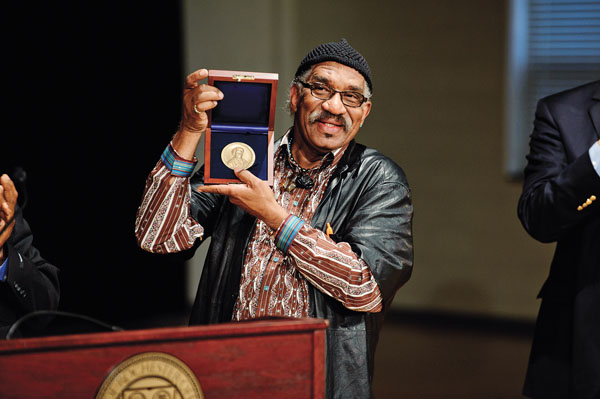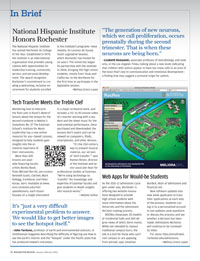In Review
National Hispanic Institute Honors Rochester
The National Hispanic Institute has named Rochester its College of the Year. Established in 1979, the institute is an international organization that provides young Latinos with opportunities for leadership training, community service, and personal development. The award recognizes Rochester’s commitment to creating a welcoming, inclusive environment for students enrolled in the institute’s programs—most notably, its Lorenzo de Zavala Youth Legislative Session, which Rochester has hosted for six years.
The University began its partnership with the institute in 2006, bringing 150 high school students, mostly from Texas and California, to the Northeast for the first time to participate in the legislative session.
—Melissa Greco Lopes
Futurity Joins ‘The Conversation’
Futurity, the website hosted by the University that features research news from top universities in the United States, the United Kingdom, and Canada, is going “Down Under.” The Conversation, a leading online source of information and commentary from universities and research institutions in Australia, now features Futurity news on its site.
Futurity’s partners are the Association of American Universities, the Russell Group of universities in the UK, and Australia’s Group of Eight Universities. The website was launched in 2009.
—Kathleen McGarvey
Web Apps for Would-be Students
As the 2011–12 admissions cycle gets under way, Rochester is offering two website innovations designed to provide high school students with more information about the University and the admissions decision-making process.
ROCRes showcases 3D models of residential halls and 360-degree views of select dorm rooms. While not intended to replace traditional campus tours, the site is a tool for those who can’t visit campus or are applying from abroad, says Jonathan Burdick, dean of admissions and financial aid.
New software updates also now allow applicants to trace their applications at each step of the process. Students can log in to a personalized account to see updates; pose questions or discuss the process; and see whether a decision has been made. Admissions decisions will continue to be conveyed by letter. For more: http://enrollment.rochester.edu/admissions.
—Melissa Greco Lopes
 MEDALIST: Tony Award–winning choreographer Garth Fagan helped mark the 25th anniversary of the Frederick Douglass Institute, where he was recognized for his leadership in the arts. (Photo: Brandon Vick)
MEDALIST: Tony Award–winning choreographer Garth Fagan helped mark the 25th anniversary of the Frederick Douglass Institute, where he was recognized for his leadership in the arts. (Photo: Brandon Vick)Douglass Institute Marks 25th Anniversary with Year of Celebration
Recognized as “one of the great reformers of modern dance,” choreographer Garth Fagan helped usher in a year of celebration for the Frederick Douglass Institute as it turns a quarter century old.
Founded in 1986, the institute promotes African and African-American studies at the University through a research-oriented undergraduate major, residential scholarships, film series, lecture series, and conferences. The institute also sponsors postdoctoral and predoctoral fellows, many of whom will be invited to return to campus this year to share their scholarly work.
“When it comes to intellectual diversity, the Frederick Douglass Institute, for the past 25 years, has been part of the solution,” says Cilas Kemedjio, director of the institute and associate professor of French and Francophone studies. “FDI has contributed to the development of graduate students and young scholars who have gone on to make significant contributions to the scholarship and teaching of African and African-American studies.”
Best known as the founder and artistic director of Garth Fagan Dance, the celebrated choreographer has taught for more than three decades at the State University of New York at Brockport and is a Distinguished University Professor Emeritus of the State University of New York. He’s the recipient of several honorary doctorates, including one from the University and one from the Juilliard School, and was awarded the University’s George Eastman Medal in 2003 for “outstanding achievement and dedicated service.”
Both popularly and critically acclaimed, Fagan has been showered with recognition for his choreography of Walt Disney’s The Lion King, earning the Olivier, the Tony, the Helpmann, and the Ovation awards for that work. More recently, Fagan’s Mudan 175/39 was named the third top dance performance of 2009 by the New York Times. —Susan Hagen
Tech Transfer Meets the Treble Clef
Wondering how to interpret the flute solo in Ravel’s Bolero? Unsure about the tempo for the second trombone in Mahler’s Symphony No. 5? The Eastman School’s Institute for Music Leadership has a new online resource for you—Speed Lessons, designed to help students gain insights into the orchestral repertoire of their instruments.
More than 100 lessons are available featuring faculty artists Bonita Boyd, flute; Michael Burritt, percussion; Kenneth Grant, clarinet; Mark Kellogg, trombone; and Peter Kurau, horn. Available at www.esm.rochester.edu/iml/ speedlessons, each lesson focuses on a single instrument in a major orchestral work, and includes a 20- to 45-minute video of a teacher working with a student and the sheet music for the instrumental performance. Once purchased and downloaded, the lessons don’t expire and can be viewed on computers, iPads, smartphones, and other devices.
“It’s the 21st-century way to present musical material, our version of ‘tech transfer,’” says Ramon Ricker, director of the institute and senior associate dean for professional studies at Eastman. “We’re using technology to ‘transfer’ the knowledge and expertise of Eastman faculty and give students in-depth insights into musical works.”
—Helene Snihur

